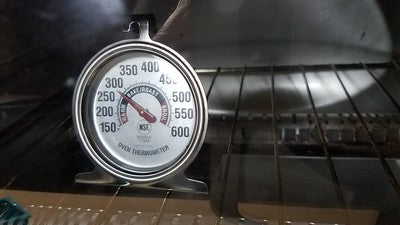Why and How to Decarboxylate your Cannabis for Tinctures
Before you make cannabis tincture or topicals, it is important to understand the role and process of decarboxylation (also known as "decarbing"). This separate process is required to "activate" the acid-form of the cannabinoids (THC-A and CBD-A) into the molecules THC or CBD. Decarboxylation permits cannabinoid compounds to interact with our body's natural endocannabinoid system.
What is decarboxylation?
Decarboxylation is a chemical reaction that removes a carboxyl group (—COOH) from a molecule, releasing carbon dioxide (CO₂) in the process. This reaction is commonly used to activate certain compounds, converting them into their more active forms by removing this specific group. Decarboxylation is often applied in chemistry and food science to unlock the full effects or benefits of certain ingredients or compounds.
Why is decarboxylation important for cannabis?
Cannabinoids present in the trichomes of raw cannabis flower exist naturally in their "acid-form", denoted by the "-A" after the molecule's name. For example, THC-A or CBD-A represents the acid form of these molecules. Decarboxylation "activates" the acid forms of the cannabinoid molecules present by releasing a CO2 molecule and converting the THC-A molecule into THC. Activation is required for the cannabinoid molecule to interact with the endocannabinoid receptors present throughout our body, brain, nervous system, gut, and skin. Without a decarboxylation step, cannabis tinctures and extracts will not provide any psychoactive effects often associated with smoking or vaping cannabis.

Why Have I Never Had to Decarb Cannabis That I Smoke?
When to Decarboxylate Your Cannabis
If making cannabis tincture to administer sublingually or topically, decarboxylating the cannabinoids before combining with alcohol is required. Why? The boiling point of 200 proof alcohol is below the temperature required to break the carboxyl-group away from the molecule.
If making cannabis tincture as the first step of making an RSO, or other cannabis concentrate, then decarboxylating can occur before, during, or after the process.
During? RSO recipes involve the slow controlled evaporation of alcohol out of solution by applying a small amount of heat over an extended period of time to reduce the alcohol tincture into a cannabis concentrate. Over the period of the evaporation step, the cannabinoids contained will also decarboxylate resulting in an activated form of the molecules contained within.
After? If you follow our recipe to reduce the alcohol content of your tincture using a no-heat method, then the final resulting concentrate will still only contain THC-A molecules. If the right amount of heat is applied to that concentrate, the carboxyl group will break free resulting in visible bubbles of CO2 emerging from the concentrate as the decarboxylation occurs.
Is it best to decarboxylate cannabis before, during, or after?
This is a matter of final delivery method (sublingual, oral, topical), personal preference, comfort level in the kitchen, surroundings that might be affected by strong cannabis odor, and equipment available to work with.
Decarboxylation Time & Temperature

Effective decarboxylation of cannabinoids is a function of time and temperature. If too little heat is applied, or not given enough time, only some of the present cannabinoids will activate, leaving behind missing potential potency in your final tincture or extract.
If too much heat is applied, or applied for too long, the newly formed THC molecule will continue to transform into cannabinol (CBN). CBN is another naturally forming cannabinoid, similar to THC and CBD, but with effects that are reported to be significantly more "sedative" than "uplifting".
It is recommended to not over decarboxylate as the effects of CBN can easily outweigh the THC that remains.
Tips for Decarboxylating Cannabis
- Use an oven thermometer to ensure that your oven's temperature is actually 250 degrees F. Don't trust the knob or the control panel read out here, as over heating the cannabis material can result in a degradation of the THC molecule being converted. Sourcing a simple oven thermometer to confirm the internal temperature of the oven is 250 degrees is worth the investment.
- Make the cannabis flower as uniform as possible so that heat is applied evenly throughout the batch. Break up large buds into small chunks no bigger than 0.5 inches (1 cm) on the largest side. If you have a mix of buds and trim leaves, consider sorting and doing the decarboxylation in 2 batches. By using uniform pieces of cannabis, heat is applied more evenly and consistently throughout the batch.
- Be prepared for strong cannabis odor while decarbing. The heat applied to activate the cannabinoid molecules will also result in a significant release of the aromatic terpenes also contained in the cannabis flower. If you live in an area where strong cannabis odor may be an issue, it is recommended that you find a place to decarb with good ventilation and away from people. Consider using a small convection toaster oven outdoors as an alternative to using the oven in your kitchen.

What does decarboxylated cannabis look like?
Cannabis that has been decarboxylated in an oven will be slightly brown in color, and dried out to the point where it easily crumbles between finger and thumb (frangible). If your cannabis remains green, or still squishy (does not break up when squeezed) it is one of the few visual signs that your process is incomplete and there is more decarboxylation that can occur with added time and heat.
How to tell when the decarboxylation process is complete?
The only way to tell if decarboxylation is complete (no remaining THCA) is to have the decarboxylated cannabis tested in a lab. These lab results can take up to 2 weeks and cost around $100, however results are provided in the parts per billion.
Unfortunately there is no way to visually tell if the decarboxylation of a cannabis flower or leaf is complete. Even if you are following a time and temperature recipe that has produced potent results in the past, the variable nature of the plant that is cannabis can alter the results between batches. If you can't or don't want to have your finished product tested, below are some ways to test the decarbed process before making alcohol tincture.
- Try some. Literally eat a small piece of decarbed cannabis and wait to see if effects kick in after 30 minutes to 1 hour.
- The only true way to know for sure if plant material has been fully decarbed is to have a laboratory analysis the material and report back on the amount of THC present. This answer can be discouraging to many, as it relies on faith coupled with some trial and error to know if your recipe is one to repeat. Furthermore, scouring the internet, one may notice that there are a variety of different opinions on the right amount of time and temperature to achieve a complete decarboxylation. Couple the variety of answers with the natural differences in starting plant material and there is much room for debate on how to optimize and standardize the decarbing process at home.
Steps to decarboxylate cannabis [Recipe]
- Preparation: Break or chop large flowers into uniform pieces no bigger than 1/2 inch (1cm) square for even heat distribution. Preheat oven to 250 degrees Fahrenheit (120 degrees C). Confirm oven temperature using an oven thermometer. Adjust oven knob or controls to get oven to rest at 250 degrees. Trust the thermometer, not your oven's knob or digital display.
- Cover a large cookie sheet in aluminum foil. Spread cannabis evenly across cookie sheet. Allow for adequate space around each piece of cannabis for maximum air flow and even heat distribution. Do not grease sheet. Do not cover in foil.
- Place cookie sheet in oven. Observe oven thermometer through oven door glass window, wait for temperature to return to 250 degrees and begin timer for 25 minutes. Do not open oven while decarbing is in process.
- After 25 minutes, remove cookie sheet from oven and cover in 2 layers of heavy duty aluminum foil for 5 additional minutes.
- After a 5 minute rest period, remove aluminum foil cover and allow to cool to room temperature before making tincture. Store decarbed cannabis in a glass jar with a tightly sealed lid. Decarbed cannabis is ready to use as soon as it cools down. Color should be light brown, and texture of the popcorn size pieces should be frangible (break easily when squeezed between 2 fingers).
Can you smoke decarboxylated cannabis?
Yes. There are no reduced effects to smoking decarboxylated cannabis vs non-decarboxylated "cured" cannabis flower.
Can you eat decarboxylated cannabis flower?
Yes. Once decarboxylated, the cannabis flower can be eaten as is, which will impart effects one would expect when consuming a cannabis gummy or baked good.
Additional Resources for Consideration
For additional scientific explanation of decarboxylation, including studies and trials with charts and data demonstrating different time and temperature combinations for decarboxylating cannabis (THC, CBD, CBG, CBN, CBV), check out these additional resources.
- Decarboxylation Study of Acidic Cannabinoids: A Novel Approach Using Ultra-High-Performance Supercritical Fluid Chromatography/Photodiode Array-Mass Spectrometry, National Library of Medicine, December 2016, Link: https://www.ncbi.nlm.nih.gov/pmc/articles/PMC5549281/
- Decarboxylation of Tetrahydrocannabinolic acid (THCA) to active THC, European Industrial Hemp Association (EIHA), October 2016, PDF Download: https://eiha.org/media/2014/08/16-10-25-Decarboxylation-of-THCA-to-active-THC.pdf
- Debunking the Myth of THC-CBN Conversion Intensity, Cat Scientific, Link: https://catscientific.com/decarboxylating-cannabis/
- How to Decarboxylate Cannabis - HomesteadandChill.com










